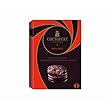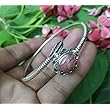1. Mate Set

Mate is the Argentine equivalent of tea and an integral part of the local culture. In fact, the city’s “porteños” (locals) don’t go anywhere without their mate kit, which comprises a special mate cup or matecito (traditionally a hollowed out gourd), a bombilla (metal straw flattened at one end and perforated at the other), a flask of hot water and a bag of herby yerba leaves that come from an evergreen tree. Drinking mate is a very sociable custom and comes with its own set of rules. To make the mate brew, you have to fill the matecito half full with yerba leaves and slowly add very hot (but not boiling) water from a flask. The cup is passed around a group of people in a clockwise order. Each drinker sips the mate through the bombilla before handing it back to the mate maker to be refilled. It’s either drunk “amagro” (bitter) or dulce (sweetened with sugar).
This artisanal Mate tea set from Arandu is made from gourd and alpaca silver and includes a mate cup and bombilla and matching yerba leaf and sugar containers. You can buy a bag of yerba tea leaves at any local supermarket for about AR$ 490.
Where to find it:
Arandu
Address: Paraguay 1259
Website: www.arandu.com.ar
Business Hours:
Monday - Friday: 9.30 am - 8.30 pm;
Saturday: 9:30 am - 1:30 pm
Buy It on Amazon:
Offline reading and travel directions:
With GPSmyCity App you can read this article offline on your mobile device, use the embedded offline city map and GPS navigation, as well as create a self-guided walk to visit the venues featured in the article.
2. Asado Knives (Facones)
Grilling huge hunks of meat on barbecue, Argentinian style, requires the right tools, and these asado knives will perfectly slice through a nice cut of meat. They can also serve as luxurious decorative pieces. Known as "facones," these are traditional Argentinian knives from the “campo” (countryside) that date back to the days when Gauchos (the traditional Argentine cowboys) used to carry them attached their belts for when the moment arose to have an asado.
For a functional yet decorative asado knife, check out Marcelo Toledo’s collection in his showroom workshop in San Telmo. Argentine-born Marcelo Toledo has been deftly handcrafting beautifully silverware since the age of 10 and he’s now one of the city’s most skillful silversmiths. His asado knives, that come in three different sizes, are handmade in 925 silver and embossed with intricate details, as well as the designer’s signature. The sheath is made of cowhide. Price: available on request.
Where to find it:
Marcelo Toledo
Address: Humberto Primo 462
Website: www.marcelotoledo.net
Business Hours:
Sunday - Friday: 10.30 am-5.30 pm (closed on Saturdays).
Offline reading and travel directions:
With GPSmyCity App you can read this article offline on your mobile device, use the embedded offline city map and GPS navigation, as well as create a self-guided walk to visit the venues featured in the article.
3. Leather Bag

As one of the world’s biggest consumers and exporters of beef, it’s no wonder that Argentina also produces some of the best leather money can buy, most of which can be found on the shopping streets of Buenos Aires. The city is saturated with leather brands and outlets offering bags in a wide range of colors, shapes and sizes. Some of the locally-produced leather bags rival those offered by fashion’s biggest luxury brands in terms of quality, but come at a fraction of the price.
Leather accessories chain Prune is a failsafe option for a good investment handbag, but if you’re looking for something more unique, luxury leather brand Escudo Prana, by designer Emiliano Albanese, does one-of-a-kind customizable leather bags hand-crafted from exotic materials and artisanal processes. This smart leather weekend bag is made from zebu hide (a crossbreed cattle with a distinctive striped fur) and features a pure silk brocade lining. The zips and other metal hardware is all individually hand-stamped and produced in-house by the designer himself. Price: available on request.
Where to find it:
La Boutique, Faena Hotel + Universe
Address: Martha Salotti 445
Business Hours:
Mondays - Sundays: 10 am-12 am.
To make an appointment to visit the Escudo Prana Showroom:
Email: info@escudoprana.com
Website: www.escudoprana.com.
Offline reading and travel directions:
With GPSmyCity App you can read this article offline on your mobile device, use the embedded offline city map and GPS navigation, as well as create a self-guided walk to visit the venues featured in the article.
4. Cowhide Rug
Not only does Argentine cowhide makes nice bags and jackets, it also makes for very stylish rugs which are another popular souvenir item in Buenos Aires. The soft, silky hides come in different colors and markings, from black and white splodges to speckled browns and stripes, depending on the breed of cow. The most common come from Holando, Hereford and Charolais cows. Funky homeware store Calma Chicha in the Palermo neighborhood sells a large collection of cowhide rugs that come in three sizes (small, medium and large). The small and medium sizes are easy to roll up and transport home. There are short haired rugs available during the summer and longer-haired rugs in the winter. Price: from ARS $990 to ARS $1,190, depending on the size.
5. Dulce de Leche
Anyone with a sweet tooth will fall instantly in love with Dulce de Leche, the country’s famous caramel sauce. It literally translates as “sweet milk” and is made from condensed milk. The average Argentine eats it at least once a day, either spread on a tostado for breakfast, stuffed in croissants or cakes or poured over ice-cream or other desserts. In fact, you’ll be hard pushed to find an Argentine dessert that doesn’t contain that all important sweet sauce. Tikal Chocolate’s creamy Dulce de Leche concoction is arguably the best in the city. Their special homemade recipe is free of any preservatives and contains delicious chunks of chocolate made from 100 percent Belgian chocolate. (You might also want to indulge in some of the artisanal boutique’s exquisite handmade chocolates while you’re there. They did take over 50 hours to produce.)
Where to find it:
Tikal Chocolates
Address: Conesa 1981, Buenos Aires
Website: www.chocolatestikal.com
Business Hours:
Monday - Friday: 8:30 am - 8 pm;
Saturday, Sunday: 10 am - 8 pm.
Buy It on Amazon:
6. Box of Alfajores
Alfajores are another one of Argentina’s guilty pleasures and the perfect sugary snack with a coffee. Different to the original Spanish cylinder-shaped confection which traditionally contains honey, almonds and spices, the Argentine version is circular and falls somewhere between a cookie and a cake. It most commonly consists of milk, dark or white chocolate-coated layers of biscuit filled with chocolate, Dulce de Leche, jam or even mousse. You’ll find alfajores in virtually every “kiosco” in the city, but the alfajores from Argentine food company and coffee shop chain Havanna, in business since the 1950s, are regarded as some of the best in the country and come in a variety of flavors. Price: A box of 12 alfajores costs AR$55.
Where to find it:
Havanna
Address: Florida 960 (multiple locations around the city)
Website: www.havanna.com.ar/
Business Hours:
Monday - Saturday: 9 am - 8 pm; Sunday: 11:15 am - 6:45 pm.
Buy It on Amazon:
7. Tango Shoes
As any professional tanguera will tell you, you can’t dance tango well without a good pair of tango heels – something that combines comfort and durable soles with elegance and a heavy dose of sparkle. And nowhere else do they make them better than the birthplace of tango itself, Buenos Aires. Numerous tango shoe designers have appeared on the scene in the last few years catering to the younger, hip crowd of tango dancers, but one of the best in town is Comme Il Faut, founded by shoe and tango devotee Alicia Muñiz. The local brand’s elegant yet comfortable shoes, designed by dancers for dancers, appeal to both professional tangueras and women generally seeking an eye-catching one-of-a-kind pair of evening shoes. Their exotic limited edition designs are colorful and incorporate high quality leather and other textured materials, and come in a range of sizes. Price: available on request
Where to find it:
Comme Il Faut
Address: Arenales 1239, Door 3, Apartment M, Rues des Artisans
Website: www.commeilfaut.com.ar
Business Hours:
Monday - Friday: 11 am - 7 pm;
Saturday: 10 am - 1 pm.
8. Rhodocrosite (Rodocrosita) Jewellery

Rhodocroiste is Argentina’s national pink stone. It’s considered a gemstone of love and wearers of it are thought to attract love so it’s frequently used in jewelry design. You’ll often hear it being referred to as the “Inca Rose” as the Incas believed it to be the blood of their ancestors turned to stone. The quality and price of the stone varies, depending on the flaws and the color which, in turn, ranges from a light pink with white streaks to a deeper and more expensive shade of reddish pink. You’ll find a lot of rhodocrosite being sold on the streets and in the markets, but if you’re looking for something a bit more special (and valuable), check out Delgè boutique’s exquisite collection of rhodocrosite jewellery. Designer and founder Ignacio Pateman incorporates a shiny, dark pink version of the stone into delicate earrings, necklaces and rings, combined with sterling silver or 19-kt gold and, sometimes, other precious and semi-precious stones, such as black onyx and pearls. Price: available on request
Where to find it:
Delgè, Hotel Sofitel
Address: Arroyo 841
Website: www.delge.com.ar
Business Hours:
Daily: 10 am-8 pm.
Buy It on Amazon:
9. Leather Jacket
A classic leather jacket never goes out of fashion and is a good solid style investment. In Buenos Aires, there are leather jackets to suit every taste imaginable, but the quality and tailoring of the jackets varies, depending on where you go, so be sure to shop around. For some of the best leather products in town, try family-run Rossi & Caruso, in business since 1862. Their products are distinguished by top quality workmanship and attention to detail. In particular, their leather jackets and vests, for men and women, come in a range of classic cuts and colors and are crafted from top notch leather that’s beautifully soft to the touch. Price: Women’s leather jackets start at around $1,400
Where to find it:
Rossi & Caruso
Address: Posadas 1387 - 1379
Website: www.rossicaruso.com
Business Hours:
Monday - Friday: 10 am - 7:30 pm;
Saturday: 11 am - 7 pm.
10. Bottle of Malbec Wine
Argentines consume vast quantities of red wine for a good reason; the country produces some of the best red wine in the world. Malbec is Argentina’s signature grape and makes a rich wine favored for its velvety texture and heady mix of fruity and spicy flavors.
One of the country’s most famous wineries is Catena Zapata, and serious vinophiles will appreciate the love and attention that has gone into a Catena Zapata Wine. Based in Argentina’s biggest wine region Mendoza, this is a family-run winery famous for revolutionizing wine cultivation by planting vineyards at high altitudes and experimenting with scientific processes to produce world-class Malbec. The Catena Zapata 2005 “Malbec Argentino” is a limited edition wine made from a carefully selected blend of grapes from the company’s best vineyards. The wine is aged for 24 months in new French oak barrels. Price: around ARS $600
Where to find it:
LD winery
Address: Suipacha 395, Edificio Plaza de la Republica
Business Hours:
Daily: 9 am - 1 am.
11. Polo Boots

Argentina is fanatical about two sports, football and polo. The latter attracts well-heeled crowds to Buenos Aires every year for the annual Championships, when some of the world’s most prestigious polo players descend on the city to play. The city is also the place to get all your polo accessories, in particular, a smart pair of custom-made leather polo boots.
Dating back to 1946, La Casa de las Botas is the most prestigious leather boot house in the city and has served an impressive roster of clients, from polo players to Royalty and celebrities. As well as polo boots that can be customized for the sport or everyday wear, you can choose from equestrian style boots and ankle-length country styles in a range of cow and buffalo hides. Since the boots are in high demand, a pair of custom-made boots takes around 30 days to make, but they will deliver to you via Fedex anywhere in the world. There is also a limited selection of boots available to buy in the shop. Price: A custom-made pair of boots will cost between 1,000 and 1,750 pesos, depending on the style you choose.
Where to find it:
La Casa de las Botas
Paraguay 5062
Website: www.lacasadelasbotas.com.ar
Business Hours:
Monday - Friday: 10 am - 6 pm;
Saturday: 10 am - 1 pm.
12. Tango Art
Buenos Aires’ deep-rooted love for tango inspires all elements of the city’s culture, from music and drama to art. Many of the city’s local artists like to paint their different interpretations of tango which make for striking, and often colorful, pieces of art. Many of these capture tango dancers clinched in passionate embraces. The best place to look for tango art is in the artisanal weekend markets of San Telmo and Recoleta.
One such artist, Buenos-Aires born Carlos Veliz, paints colorful tango poses on piece of fabric using acrylic paint. His unique, contemporary artwork perfectly captures the vibrancy, passion and emotion of the dance. You can find him just opposite the entrance to Recoleta Cemetery every Saturday and Sunday. Price: His smaller prints start at ARS $100 and go up to around ARS $800
13. Fernet

For those who prefer hard liquor to the grape, Argentina has harbored a love for Fernet, a bitter, aromatic spirit, since the 1800s. The syrupy drink’s original purpose was to cleanse the system after a heavy meal or rid the body of contaminants in the water. And even today, Fernet is touted for its medicinal benefits and is believed to alleviate stomach pains and hangovers due to its herbal contents. It’s made from around 40 to 50 different herbs and spices, such as myrrh, chamomile, cardamom and saffron, and characterized by a medicinal, earthy taste (not dissimilar to mouth wash). The Argentines most commonly like to mix it with Coca Cola (and a few cubes of ice) or have it as a digestif on the rocks, but it goes well with soda water too. For a long time, the Italian brand Fernet Branca was the most popular Fernet on the market, but the Argentine brand 1882 has recently emerged and attracted a strong following of Fernet drinkers. Price: A 750cc bottle of Fernet 1882 is ARS $36
Where to find it:
Ligiers
Address: Tte. Gral. J. D.Peron 1621
Website: www.vinotecaligier.com
Business Hours:
Monday - Friday: 9.30 am - 7 pm
Saturday: 10 am - 1 pm.
14. Polo Shirt
Preppy polo fashion is popular in Argentina on and off the pitch. Whether you’re after a polo shirt, as sported by Argentina’s national team for a budding polo fan, or something more fashionable to wear on the weekends, head to La Martina, the country’s luxury polo brand and official sponsors to the polo team. The luxury polo and sportswear brand, which has boutiques in numerous locations across the city, offers a collection of fetching polo shirts in a range of styles that strike a balance between sporty and stylish and come in a palette of colors to match the season. Price: available on request
15. Boca Juniors Football Shirt
Argentina’s passion for football is up there with its love of red wine, steak and tango. The locals are fervent football fans, and take the game very seriously. One of the city’s most beloved and successful teams is Boca Juniors from the colorful La Boca neighborhood in the south of the city, where the famous Diego Maradona started his football career. The team’s strip is bright blue and yellow (legend has it that the colors were inspired by the Swedish flag, the first boat to arrive in the La Boca harbor). You’ll see Boca Juniors football shirts on sale all over the city, but to ensure you’ve got the real thing and not a fake, it’s advisable to buy one from a sports shop rather than a street stall or tourist stall (otherwise it may have fallen apart at the seams before you’ve even got it home). Price: ARS $369
Where to find it:
Just for Sport
Address: Florida 431
Business Hours:
Daily: 10 am - 9 pm.
Buy It on Amazon:
Other Interesting Souvenirs from Argentina
If traveling to Argentina is not on your immediate agenda, or you simply can't afford an extra space in your luggage, fortunately, these days, you can find a wide selection of authentic and truly interesting Argentinean souvenirs online. Presented here are some of the Argentinean products sought by foreign visitors, now available online for your convenience.
1. Argentina Soccer Jersey - Soccer-mad Argentina boast a proud World Cup history, having won the prestigious trophy two times! The famous sky blue and white of Argentina, worn by legends like Diego Maradona and Lionel Messi, is one of the most recognized jerseys in the world.



2. Argentine Tango CDs - The world's symbol for Argentina, traditional tango is played on a solo or duo guitar, or accompanied by an ensemble of two violins, flute, piano, double bass, and at least two bandoneóns (imported accordion-like German instrument). Totally improvisational, Argentine tango is the soul of Buenos Aires expressed through a song, in which the city's inhabitants have given up their sorrow to the music.






3. Yerba Mate - Mate is a tea-like beverage much popular in Argentina as well as in the neighboring Uruguay, Paraguay and Brazil, where it is a rival alternative to coffee. The infusion is brewed from the dried leaves of Yerba Mate (Ilex paraguariensis), a native plant of subtropical Latin America, which is rich in vitamins and minerals, contains more antioxidants than green tea, and less caffeine. A perfect balance to start a day!




4. Chimichurri Sauce - A staple ingredient of Argentinean food culture, Chimichurri is a mix of fresh herbs, garlic, vinegar and oil. This is a perfect marinade and condiment for beef, chicken, pork or seafood. Magnificently bold and complex in flavor, it makes an excellent dipping sauce for bread or addition to your rice, pasta, roasted vegetables, sandwiches, and omelets.



.jpg)





-jewellery.jpg)


































